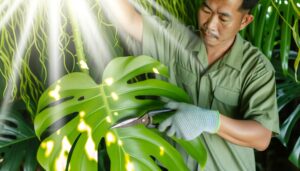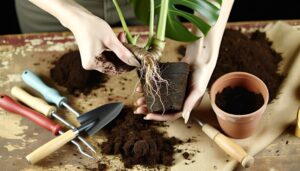Can Monstera Aerial Roots Be Planted? A Complete Guide!
Yes, you can plant Monstera aerial roots in soil. These roots, originally intended for anchorage and nutrient absorption from the air, will adapt to soil conditions and contribute to the plant’s stability and growth.
Be sure to soak the roots in water before planting and use a rooting hormone for better development. Monitor soil moisture closely and guarantee proper drainage to prevent root rot.
Planting aerial roots will improve the Monstera’s structural integrity and nutrient uptake. For more detailed steps and tips on the process, keep exploring the topic.
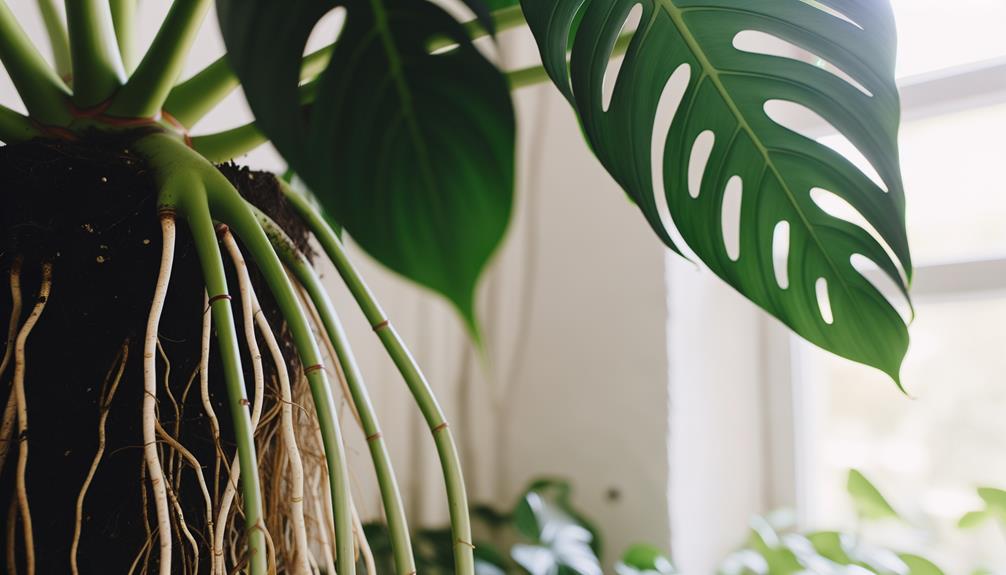
Key Takeaways
- Yes, Monstera aerial roots can be planted in soil to enhance stability and nutrient uptake.
- Aerial roots adapt to soil conditions, helping the plant grow stronger and healthier.
- Proper preparation and care of aerial roots are essential for successful soil integration.
- Ensure consistently damp soil and good drainage to prevent root rot.
- Aerial roots can be used for propagation and creating new Monstera plants.
Understanding Aerial Roots
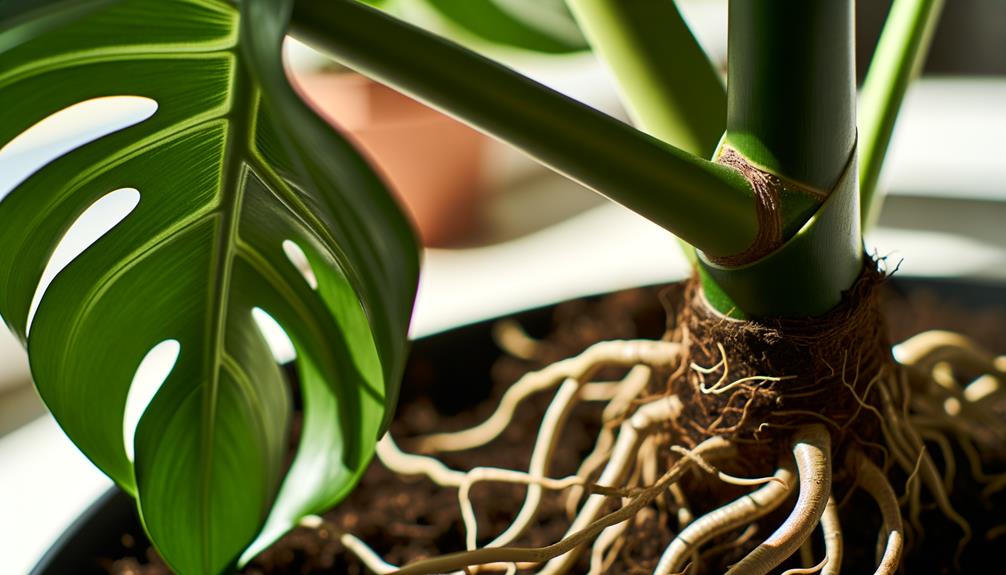
To fully appreciate the role of aerial roots in Monstera plants, you need to understand their unique structure and function within the plant’s overall physiology. Aerial roots are specialized roots that grow above the soil surface. They often emerge from the plant’s nodes, which are the points where leaves and stems intersect.
These roots are typically thicker and more robust than soil roots, and they exhibit a distinctive, bark-like texture. Composed primarily of lignified cells, aerial roots provide structural support and assist in water and nutrient absorption from the air and surrounding surfaces.
Their ability to anchor the plant to various substrates, such as trees or trellises, reflects their evolutionary adaptation to tropical rainforest environments where Monstera species naturally thrive.
Purpose of Aerial Roots
Aerial roots in Monstera plants serve multiple essential functions, including structural support, nutrient absorption, and anchorage to surfaces like trees or trellises. These roots provide stability as the plant climbs, ensuring it can reach sunlight efficiently.
They absorb moisture and nutrients from the air and surrounding environment, which supplements the plant’s nutritional needs. Additionally, aerial roots enable the plant to attach itself to various surfaces, allowing it to grow vertically and expand its reach.
This adaptation is pivotal for Monstera’s survival in its natural habitat, where competition for light and space is fierce. By understanding these functions, you can better appreciate the crucial role aerial roots play in the overall health and growth of your Monstera plant.
Differences Between Root Types

You’ll notice that Monstera plants have two main types of roots: aerial and soil roots. Aerial roots grow above the ground, helping the plant cling to surfaces and absorb moisture from the air, while soil roots anchor the plant and absorb nutrients from the soil.
Understanding the functions and adaptations of these root types is essential for proper care and propagation.
Aerial Vs. Soil Roots
Unlike soil roots that anchor the plant and absorb nutrients from the ground, aerial roots of the Monstera serve different functions such as supporting the plant as it climbs and absorbing moisture from the air.
Soil roots grow underground, establishing a stable foundation and accessing nutrients and water from the soil. In contrast, aerial roots emerge from the stem above ground, adapting to the plant’s climbing nature. These roots have specialized cells that allow them to cling to surfaces and absorb atmospheric humidity.
Soil roots are typically thicker and more robust, designed for nutrient uptake and structural stability. Aerial roots, however, are often thinner and flexible, enabling the Monstera to thrive in its natural tropical habitat.
Function and Adaptation
Monstera plants demonstrate a fascinating dichotomy in their root systems, with each type of root soil and aerial evolving specialized functions to support the plant’s survival and growth in diverse environments.
Soil roots anchor the plant firmly into the ground, absorbing essential nutrients and water. These roots are vital for the plant’s overall stability and nourishment.
Aerial roots, however, serve a different purpose. They emerge above ground, helping the plant climb and attach to surfaces like tree trunks, which aids in reaching light. Additionally, aerial roots can absorb moisture and nutrients from the air, supplementing the plant’s nutritional needs.
Understanding these differences helps you better care for your Monstera, ensuring both root types function efficiently.
Can Aerial Roots Grow in Soil?
Aerial roots can indeed grow in soil, where they will help stabilize the plant and absorb nutrients. These roots are versatile and can adapt to soil conditions. When you plant them, they function similarly to subterranean roots, assisting in nutrient and water uptake. This adaptability enhances the plant’s overall health and growth.
Here’s a concise comparison:
| Root Type | Function | Adaptability to Soil |
|---|---|---|
| Aerial Roots | Stabilization, nutrient absorption | High |
| Subterranean Roots | Primary nutrient absorption | Naturally adapted |
| Both Combined | Enhanced support and growth | Maximum effectiveness |
Understanding the roles and adaptability of these roots allows you to optimize your Monstera’s growth. By incorporating aerial roots into soil, you’re enhancing the plant’s structural integrity and nutritional intake.
Preparing Aerial Roots for Planting
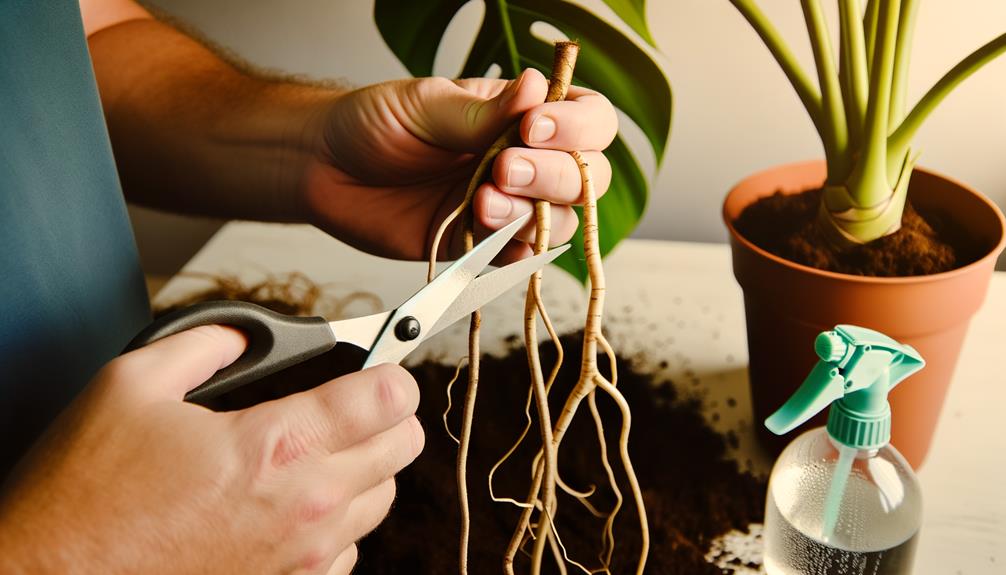
To prepare aerial roots for planting, first make sure they’re healthy and free of any damage or disease. Examine the roots closely, looking for signs of decay, discoloration, or pests. If you find any damaged sections, trim them off with sterilized pruning shears.
Next, soak the aerial roots in water for about an hour; this will hydrate them and make the transformation to soil easier. After soaking, apply a rooting hormone to the cut ends to encourage root development.
Choosing the Right Soil
When choosing soil for Monstera aerial roots, you should focus on a mix that supports both aeration and moisture retention. Guarantee the soil is rich in organic matter and contains components like perlite or bark for peak drainage.
This balance will prevent root rot while providing essential nutrients for healthy growth.
Soil Composition Essentials
In order to secure the healthiest growth for your Monstera aerial roots, it’s important to select a well-draining soil mix rich in organic matter. This safeguards the roots receive adequate nutrients while preventing waterlogging.
You should aim for a mix containing equal parts peat moss, perlite, and pine bark. Peat moss retains moisture and nutrients, perlite improves aeration and drainage, and pine bark provides structure and slow-releasing nutrients.
Avoid heavy soils like clay, as they can compact and suffocate the roots. Additionally, incorporating a small amount of compost can enhance microbial activity, fostering a healthier root environment.
Optimal Drainage Solutions
Choosing the correct soil composition not only guarantees nutrient availability but also emphasizes the importance of ideal drainage solutions for your Monstera aerial roots. To achieve this, you should opt for a well-draining soil mix. A mix containing peat, perlite, and pine bark works wonders.
Here’s a useful breakdown:
| Component | Function | Ratio |
|---|---|---|
| Peat Moss | Retains moisture, provides nutrients | 40% |
| Perlite | Enhances aeration, prevents compaction | 30% |
| Pine Bark | Improves drainage, adds organic matter | 30% |
This balanced blend secures that excess water won’t suffocate the roots, reducing the risk of root rot. Remember, your Monstera’s aerial roots need both air and moisture to thrive.
Steps to Plant Aerial Roots
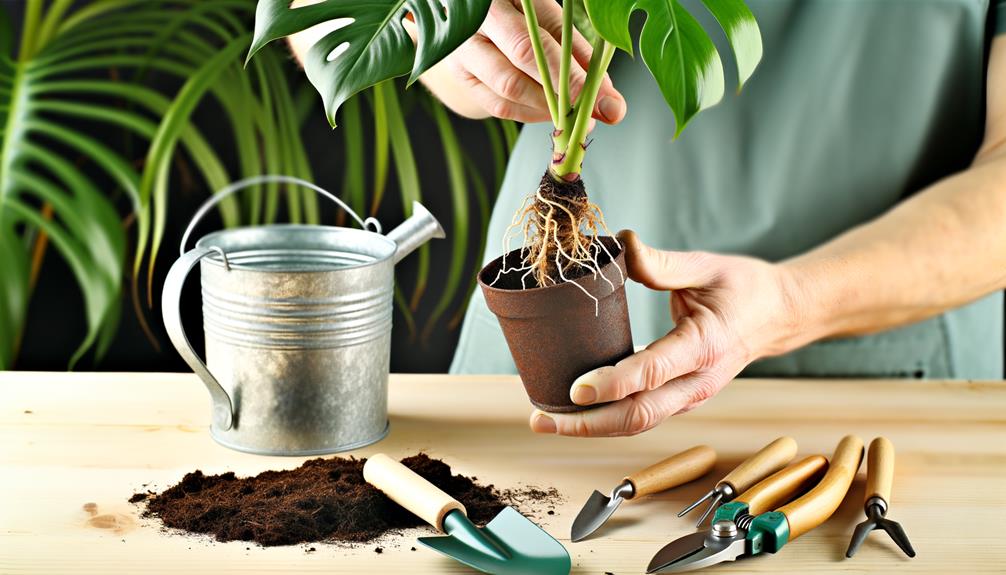
To plant Monstera aerial roots, start by preparing a clean, sharp knife or scissors to cut the roots precisely. Next, identify healthy, mature aerial roots. Cut these roots close to the main stem, guaranteeing a clean cut to prevent damage.
Fill a pot with a well-draining soil mix, ideally containing peat, perlite, and orchid bark. Make a small hole in the soil and insert the aerial root, ensuring it’s adequately covered but not buried too deep. Lightly press the soil around the root to secure it in place.
Water the soil thoroughly, allowing excess water to drain out. Guarantee the pot is placed in a location with indirect sunlight to promote healthy growth.
Caring for Planted Roots
After planting the Monstera aerial roots, monitor the soil’s moisture levels closely to make sure the roots don’t dry out or become waterlogged. Aim for soil that’s consistently damp but not soggy. Use a moisture meter or your finger to check soil conditions regularly.
Ensure the pot has good drainage to prevent root rot. Fertilize with a balanced, water-soluble fertilizer every 4-6 weeks during the growing season. Maintain ambient humidity around 60% to encourage healthy root development.
| Aspect | Ideal Condition | Frequency |
|---|---|---|
| Soil Moisture | Consistently damp | Regularly |
| Fertilization | Balanced, water-soluble | Every 4-6 weeks |
| Humidity | Around 60% | Sustain daily |
With these steps, you’ll nurture robust growth and a flourishing Monstera.
Common Mistakes to Avoid
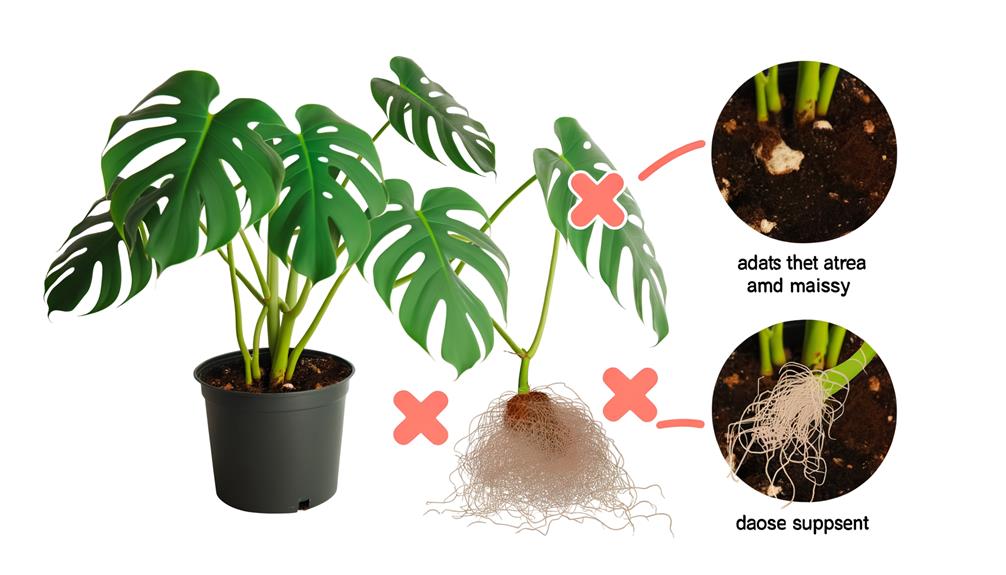
One common mistake to avoid is overwatering, which can lead to root rot and severely damage your Monstera. Make sure the soil is well-draining and only water when the top inch feels dry.
Another error is planting the aerial roots too deep. Aerial roots are designed for support and nutrient absorption from the air, so burying them can suffocate and kill them.
Additionally, neglecting to acclimate the roots can cause shock. Gradually introduce the roots to soil by lightly covering them before fully planting.
Benefits of Planting Aerial Roots
Planting aerial roots can greatly enhance your Monstera’s stability and nutrient uptake, promoting robust growth and overall plant health. By embedding these roots into the soil, you provide additional anchorage, reducing the risk of the plant toppling over.
This practice also allows the aerial roots to absorb extra moisture and nutrients directly from the soil, supplementing the primary root system.
| Benefit | Description |
|---|---|
| Improved Stability | Secures the plant in an upright position, preventing damage from falling |
| Enhanced Nutrient Uptake | Aerial roots can absorb additional nutrients, boosting plant essentiality |
| Increased Moisture Absorption | Helps maintain consistent hydration levels |
| Root Propagation | Stimulates the growth of new roots, enhancing overall root structure |
| Healthier Growth | Supports robust growth, leading to a healthier, lush Monstera |
These benefits collectively foster a thriving Monstera, making aerial root planting a valuable practice.
Alternative Uses for Aerial Roots
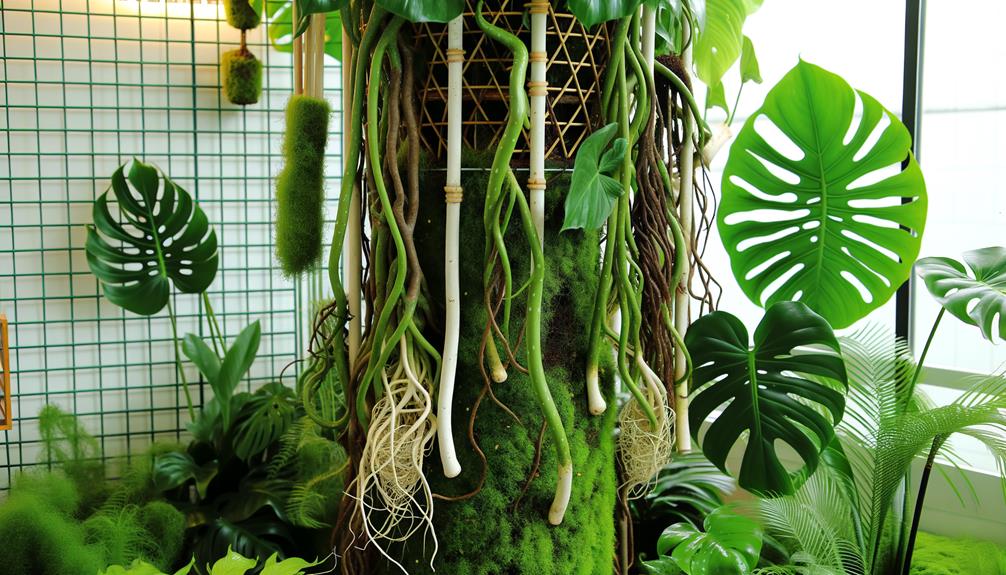
Aerial roots of Monstera plants offer versatile applications beyond their primary role in nutrient absorption and stability, serving as natural humidity gauges and even potential propagation tools.
You can observe these roots to gauge the humidity level in your environment; they tend to grow more vigorously in higher humidity, indicating the need for a more humid atmosphere.
Moreover, you can use these roots for propagation. By burying them in soil or placing them in water, you encourage new root systems to develop, leading to new plant growth. This method can be particularly useful for expanding your Monstera collection.
Aerial roots can support the plant’s structure when trained to climb a moss pole, enhancing both stability and aesthetic appeal.
Conclusion
Coincidentally, while you were learning about monstera aerial roots, you might’ve wondered if they could thrive in soil. By chance, with proper preparation and care, they can!
Understanding the unique functions and differences of these roots helps you plant them correctly. Avoid common mistakes, and you’ll enjoy the benefits of stronger, healthier plants.
Additionally, aerial roots also have alternative uses, making them versatile. Now, you’re equipped to experiment scientifically and enhance your plant care skills.

